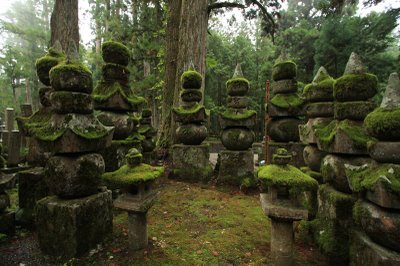
Credit last year’s Michelin Green Guide Japan. Or perhaps, the area’s 2004 listing as a World Cultural Heritage Site. Whatever the reason, Europeans are visiting the sacred Koyasan area in droves.
Located in secluded Koyacho, Wakayama Prefecture, the area used to receive about 4,000 to 5,000 European visitors annually, according to prefecture officials, but since 2004 this number has been steadily increasing.
Last year, when Michelin gave three stars to Koyasan in the French version of its Green Guide Japan travel guide, Koyasan attracted 25,000 visitors from Europe, and about 13,000 of these from France.
The total number of foreign visitors reached 38,000, according to the prefectural government.
The Michelin guidebook, which introduces Japanese cultural assets and scenic areas, recommends Koyasan because of its mysteriousness and isolation from so-called daily life.
A French tourist, 31, who had learned about Koyasan from the guidebook, was full of praise, admiring the “harmonious area’s people, religion and atmosphere.”
Famous for more than 100 temples in the middle of mountains, the area was settled by Kukai, also known as Kobo Daishi (774-835), and is recognized as the center of the Shingon sect of Buddhism. Its headquarters, at Kongobuji temple’s Danjo Garan complex, are about 900 meters above sea level.
The shrines and towers in the district are reminiscent of the days when those structures were first founded.
Speculating why Europeans are so enamored of Koyasan, Kurt Genso, a Buddhist priest from Switzerland, said it bears similarities to the Italian mountainous town of Assisi, long associated with the Catholic religion. The Swiss priest, 59, has been in religious training at Muryokoin temple since 1997.
In Europe, so-called spiritual tours, in which participants escape their daily routines and visit holy sites, are popular.
“I think people visit Koyasan not for sightseeing but instead as a special pilgrimage,” Kurt said.
The Koyasan area has 117 temples, about half of which have shukubo lodgings, providing overnight accommodation and meals for visitors. Visitors can participate in morning religious services.
Foreign visitors are welcome, with pamphlets available in French, and many restaurant menus written in English.
“In the past, foreign tourists visited Koyasan after Nara or Kyoto. Recently however, increasing numbers of sightseers are coming to Japan specifically to visit Koyasan, where they can read books and relax in shukubo lodgings,” said Noriki Ueki, a Koyasan Tourist Association official.
Source: www.kentucky.com




